The second team of Austrian Bundesliga club Austria Vienna which is also known as Young Violets are one of the most impressive teams in Austria’s second division. The 43-year-old Harald Sucher formed a team which is able to dominate opposition for most parts of the game even though they are behind FC Liefering (second team of RB Salzburg) the team with the second-lowest average age. While Liefering’s squad have according to Transfermarkt an average age of 19.1 years, Young Violets have a value of 19.2 years.
Still, they finished in the 2019/20 season in the fourth position behind Liefering, Austria Klagenfurt and champions Ried. Additionally, they are according to many statistics the most dominant side of the league with on average 59.2% of possession (best value of the league), 454.99 passes per 90 (best value of the league) and additionally 33.35 dribbles per 90 what is the second-highest value of all teams in Austria’s second division.
In this scout report and tactical analysis, we will look at the possession tactics of Young Violets to understand how they are able to dominate the opposition and finish in a solid fourth position in the second Austrian tier.
System
Basically, Sucher lined up his team in the recent season in different formations and didn’t always choose the same. However, he clearly prefers the back four compared to a backline with three and five defenders respectively since the only time he went with this was when they received a red card.
Otherwise, he mainly lines his team up in a 4-1-4-1 or 4-3-3 (not really much of a difference between these two formations) and also sometimes used a 4-2-3-1. In the final match of the 2019/20 season against Kapfenberg, he decided to line up his team in a 4-1-3-2 what is quite unusual as they played with two strikers. We can see in the image below how often Young Violets used which formation in the 2019/20 season in Austria’s second division.
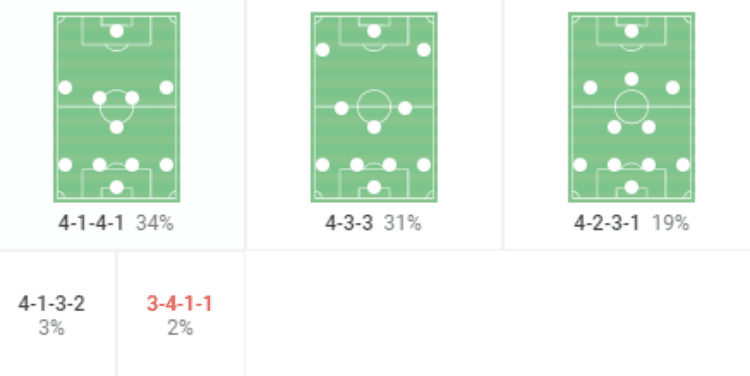
The positioning of the players during the opening phase
We will go through the several principles which are the basics for the whole style of play of Young Violets to break down the tactics in its different parts. For each principle, we will have an own part and subheading respectively, but still, it is very important to note that the combination of all these principles is what makes them so strong.
In the first part of the scout report, the positioning of the deeper players during the first stage of the build-up will be the subject. Therefore, we will focus on the defenders and midfielders.
Basically, their most-used structure is that they build-up with four defenders and one deep midfielder who stays in front of the two centre-backs. By doing so, they have enough bodies in the deeper areas to always have at least one safe passing option. The remaining five players are mainly positioned variably in the central areas upfront as we will discuss later in this tactical analysis. Below, a perfect example of this 4-1 is visualised.
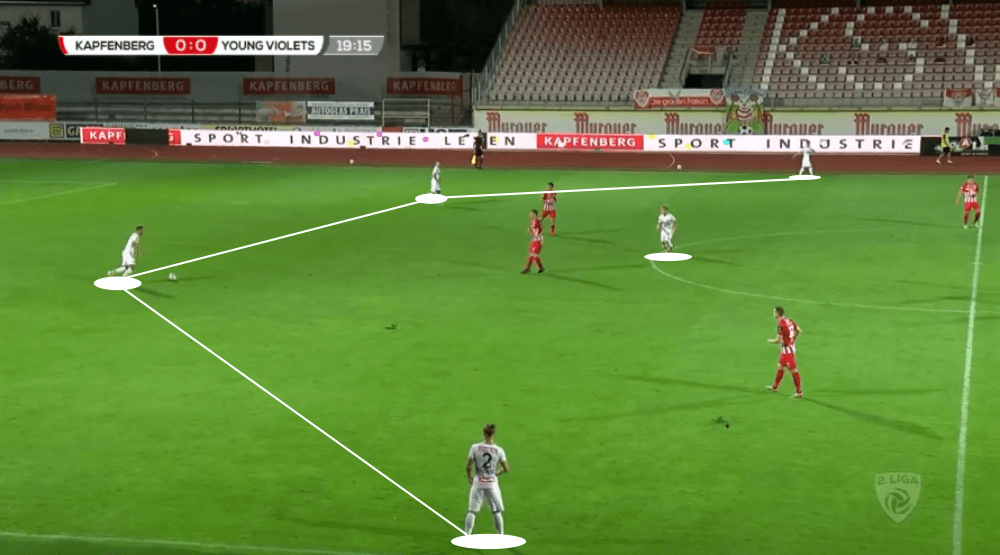
On some occasions, the two full-backs already push higher up the pitch during the first phase of the build-up what means that the distance between them and the central defenders gets quite long. In those situations, one of the more advanced central midfielders tends to drop deeper on one side to provide the centre-backs with an additional short passing option.
In the following example, the left-back Lukas Prokop pushes forward since the opposition sit back quite deep meaning that not necessarily both full-backs are needed for a save ball circulation. However, since both wide defenders (right-back out of the frame) are positioned very high, the two centre-backs and the defensive midfielder find themselves in a 3vs2 against the two strikers of Dornbirn in their 4-4-2. To give them one additional option, the central midfielder Matthias Braunröder comes deeper to help them.
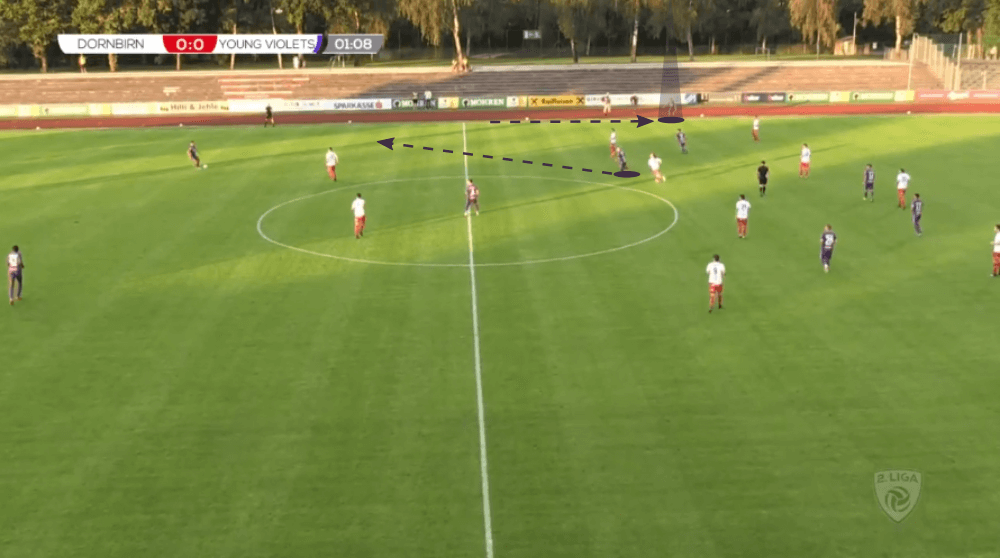
It’s hard to say if the solution of Braunröder in the example above is how the coach Suchard wants him to position as soon as both wide-defenders move that high or if the 18-year-old had the feeling that his teammates would need his help.
Occasionally, the deepest midfielder not just stays in front of the back four, but also drops between the central defenders. In those situations, another central midfielder immediately comes deeper to position in the area in front of the own last line. Besides, in those situations, the full-backs have to move high up the pitch since the central defenders split wide and otherwise they would occupy the same space as we can see below.
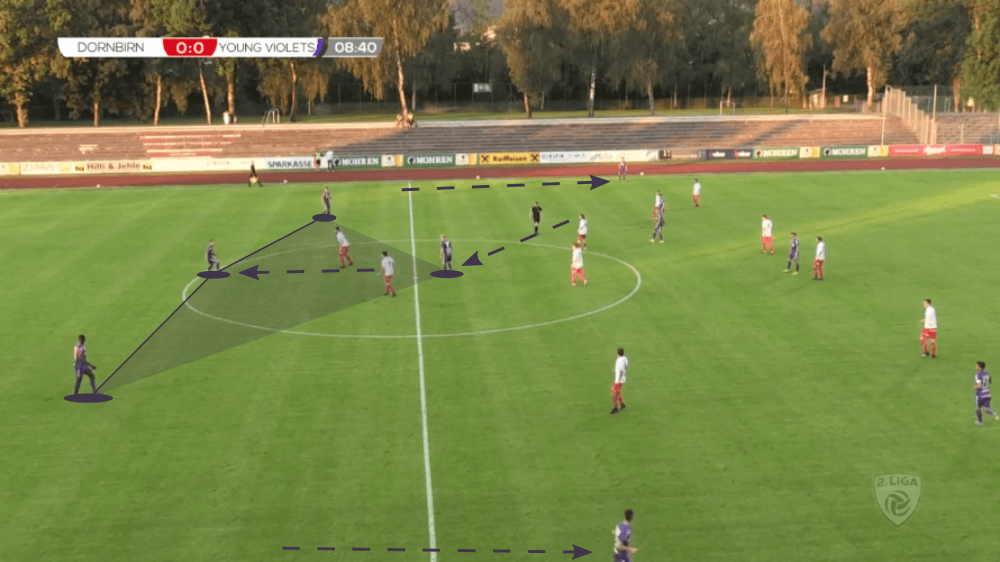
To conclude this part of the tactical analysis, they mainly use a 4-1 structure during the first stage of the build-up, but the central midfielders are encouraged to come deeper when they see that their teammates need an additional passing option. The team of Suchard prefers to have a sequence of successful passes before they start with the actual progression of the ball meaning that the dropping of a central midfielder or the general deep position of the full-backs is especially to always have enough save passing options during the first stage.
Ready to take risks
Now that we understand their positioning during the first phase of the build-up, the focus in the following three chapters is mainly on the way they progress the ball and enter the final third while in the final part we will look at their main principle to create goalscoring chances.
One central aspect of the tactics of Suchard is that even though during the first stages of the possession phase he wants his team to have a few simple passes to gain confidence and move the opposition, he also wants to see that his players take risks to get forward.
The defensive/central midfielder Braunröder is probably the best example as he is a save passer of the ball and often the player who organises the build-up, but also tries to receive the ball under pressure and is ready to solve such situations with a dribble or a pass. The 18-year-old loves to be the one player ahead of the four defenders and then positions between the opposition’s strikers and midfield line.
Even though he receives in such situations immediate pressure from several players, he actively demands the ball as he is ready to take the risk. In the example below, he solves the situation with two intelligent touches to then get fouled.
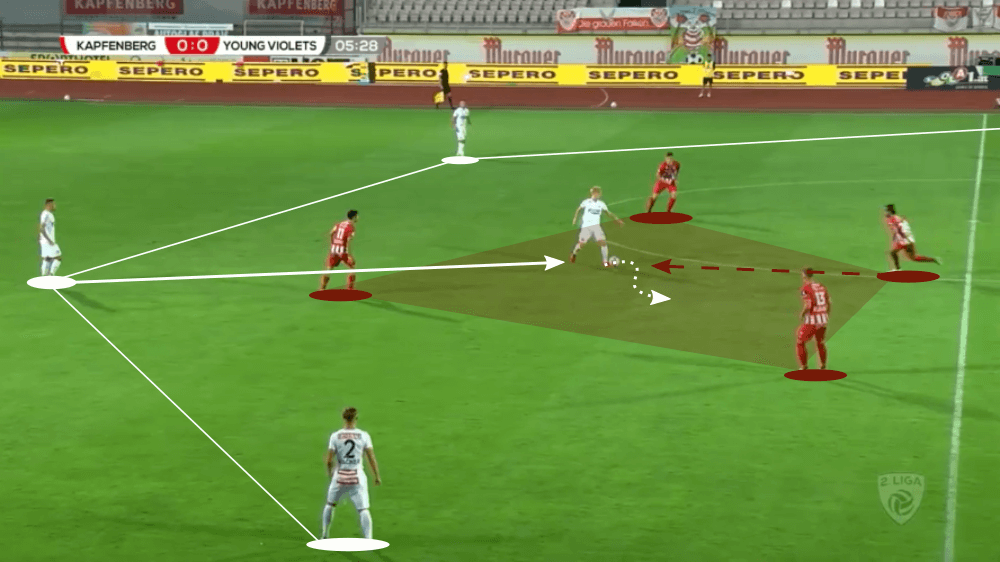
Additionally, the young men from Young Violets are encouraged to take on opponents in 1vs1 situations even in the own half as long as it gives the attack a massive boost when it is successful. Without any question this a central reason why they are behind FC Liefering the team with the second-most attempted dribbles per 90 minutes (on average 33.35).
Below, we can see a perfect example as the right-back Pascal Macher detects the free space in the centre and knows that his opponent expects the pass to the outside to Muharem Huskovic (#16). Due to that, he starts with the ball at his feet a sprint to enter the vacant space in the middle.
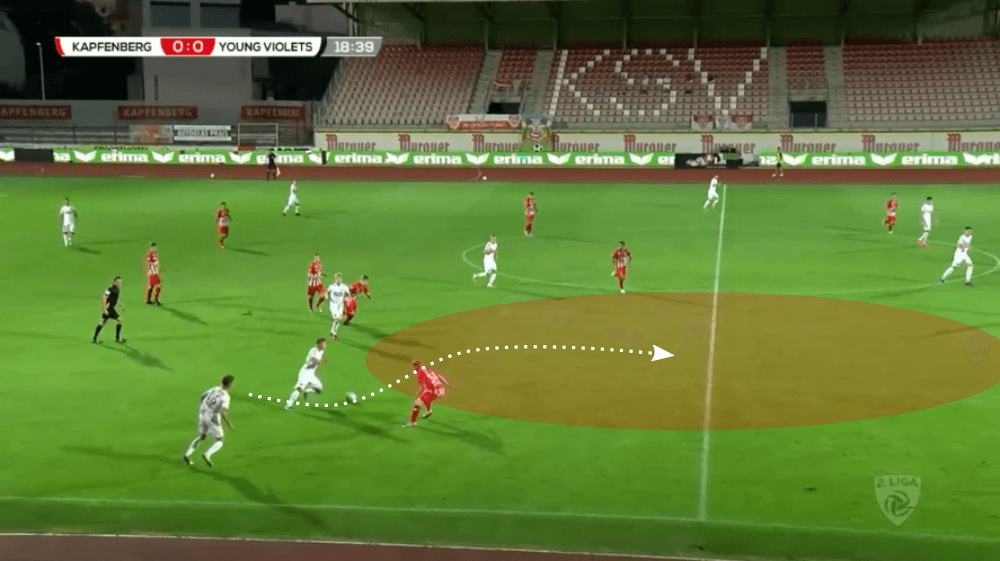
Also, Suchard’s team try to stay calm under pressure and are always looking for the solution via short passes and dribbles. When the opposition press in at them very high up the pitch, they see it as a chance to bypass the pressing and then exploit the free space behind the players who press in at them.
Considering this, they are ready to take risks to then get into situations like the one below in which they then have a lot of space and can exploit the pace of their players via through passes.
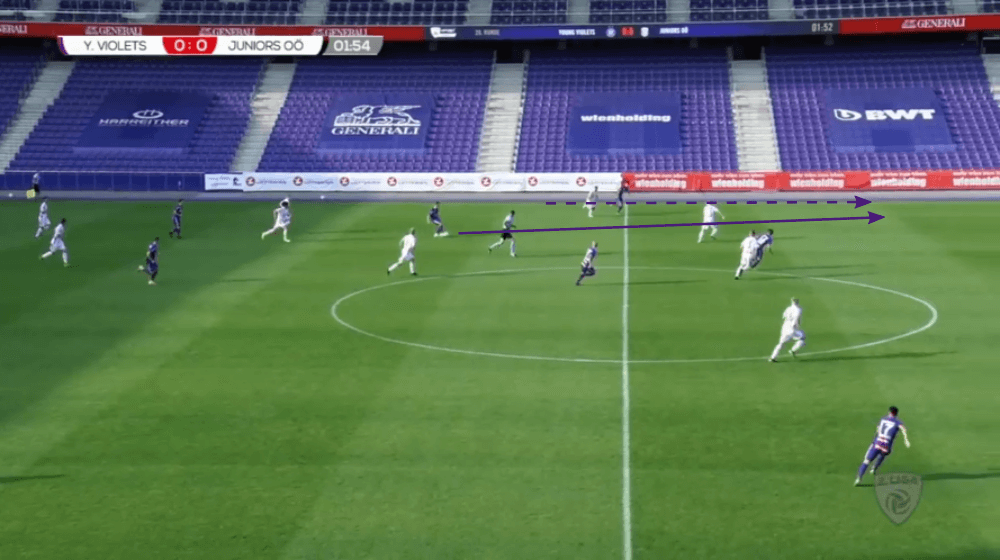
In conclusion, the players of Suchard should be brave enough to receive balls under pressure and solve situations with short passes or dribbles if realistically possible to then have more space further up the pitch.
Enough bodies in the centre to play forward passes
In the next two chapters of this scout report, we will discuss the positioning of the players in the higher areas of the pitch. Basically, Suchard likes his players to overload the central areas between the opposition’s defensive line and midfield to have firstly enough men in the centre to create vertical passing lanes and secondly to force the opposition to defend very compactly and narrow what offers Young Violets space in the wide areas.
In the following image, the left-back Prokop is on the ball and the left-winger Can Keles is in the left wide area. Braunröder (CM – #7), Niels Hahn (CM – #28), Huskovic (CF – #16) and Anouar El Moukhantir (RW – #17) are positioned in the central area (half-space or the central zone) of the pitch while on the opposing side the right-back provides width (out of the frame). Please note that the lines are completely exact and mainly should help to get a feeling for the positioning of the players.
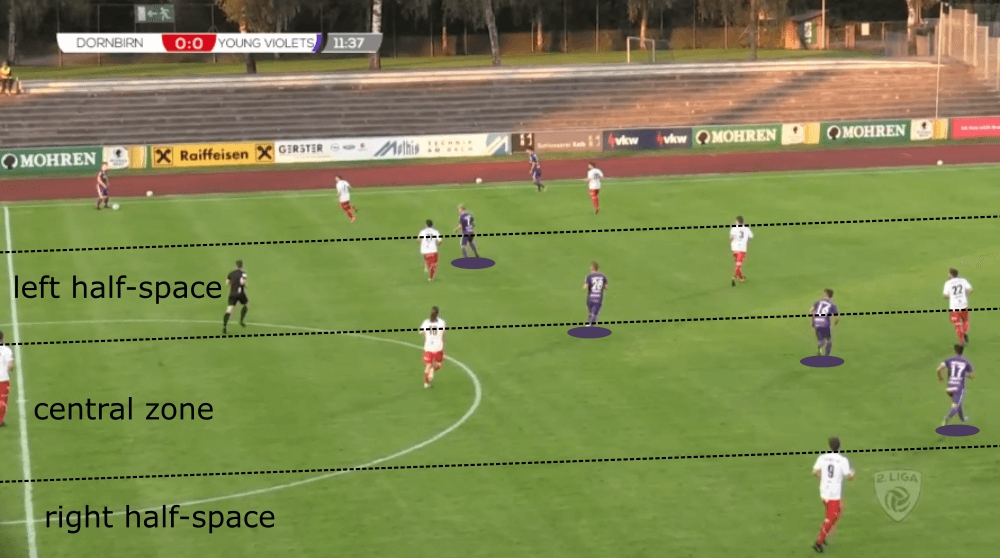
This image perfectly shows us their structure when they try to progress with the ball higher up the pitch. Suchard wants that each half-space and both wings are occupied by one player while in the central zone there can be two or even three men.
A central goal is that they are never in the exact same vertical line since otherwise, they would take each other out of the game. However, when their positioning and movements are decent, they create vertical passing lanes which the central defenders or the deepest midfielder can exploit as we can see in the example below.
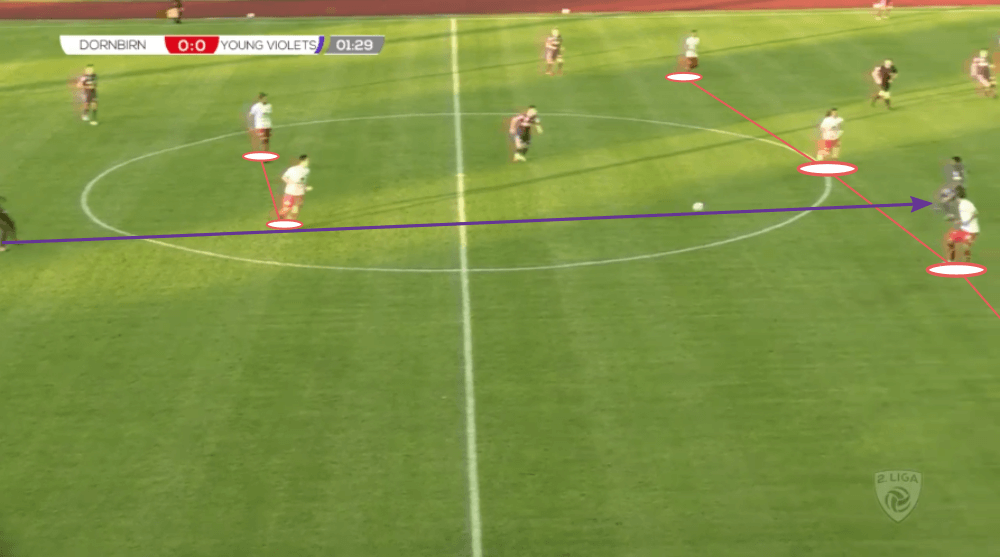
Besides, these penetrating passes don’t always need to be low-driven powerful passes as sometimes they also use long balls to overcome the midfield of the opposition. This is especially the case whenever there is a lot of space between the midfield line and the defence. The receiver then should try to lay it off for a teammate as in the image below.
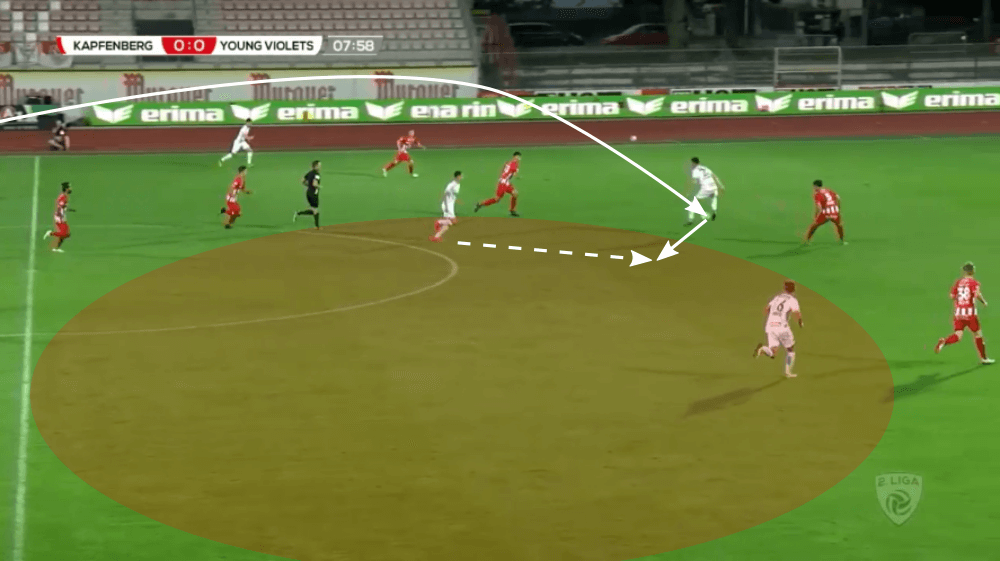
Only one player on the wing
Suchard wants that the half-spaces are mainly occupied by exactly one player while there is the same rule in place for the wings. We can rarely see that there are two players on the wing during the possession phase. The only situations in which this is the case is during the early stage during the build-up when the wingers aren’t fully tucked in yet.
When the full-back is in the wide area, the winger moves into the centre and the other way around too. In the situation below, we can see again the left-back Prokop on the ball, but this time in the half-space and the left-winger Keles provides width. Once again, the other players are positioned in the centre and half-spaces. Again, the lines are only as help and not that exact.
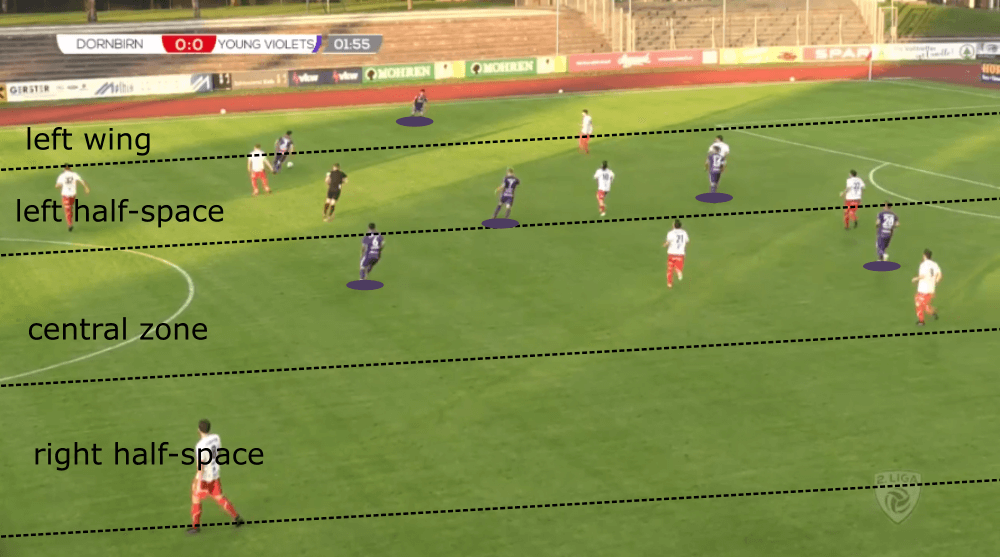
In the final third, the wingers and full-backs logically try to avoid that they take each other out of the game and due to that the full-backs not necessarily always join their teammates in the final third. Instead, they stay deeper to be in a good positioning to intercept passes or start a counter-pressing as soon as the team loses the ball.
In the example below, the right-back Facundo Perdomo stays deeper to not be in the same area as the winger El Moukhantir who receives a decent through pass.
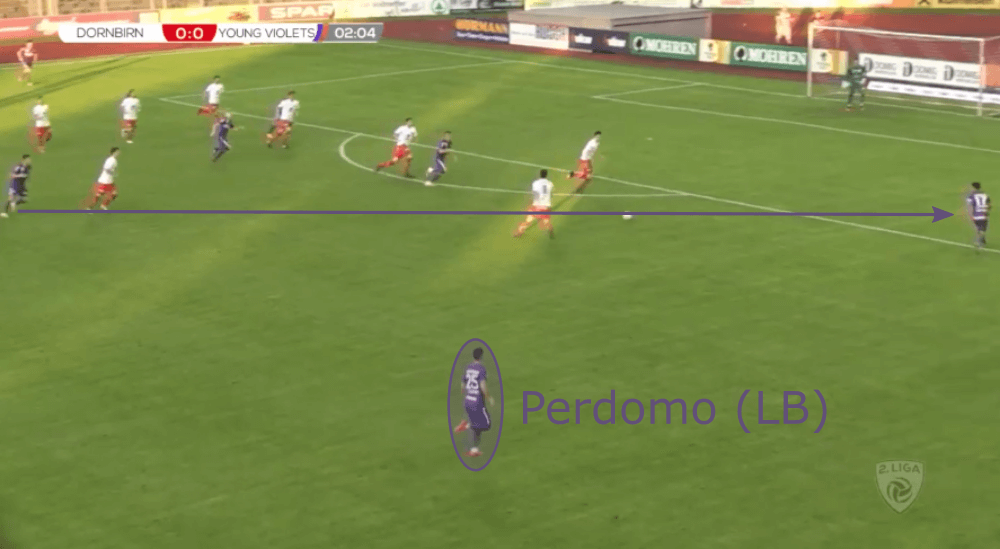
Low crosses as the main principle in the final third
Such through passes as we can see in the example above are beside the low crosses the main way how Young Violets try to create goalscoring chances in the final third. Such low crosses are also often used by EPL giants Manchester City, for example. The former Bayern Munich and Barcelona coach Pep Guardiola encourages his players to break through on the wings to then deliver low-driven crosses.
Suchard has a similar idea of how his team should create the chances in the final third while we have to distinguish clearly between two kinds of crosses. When the player on the ball has still some distance between himself and the goal line and additionally there is space between the potential receiver/the defenders and the goalkeeper, the cross should be exactly in this space between the striker and opposing keeper as we can see below.
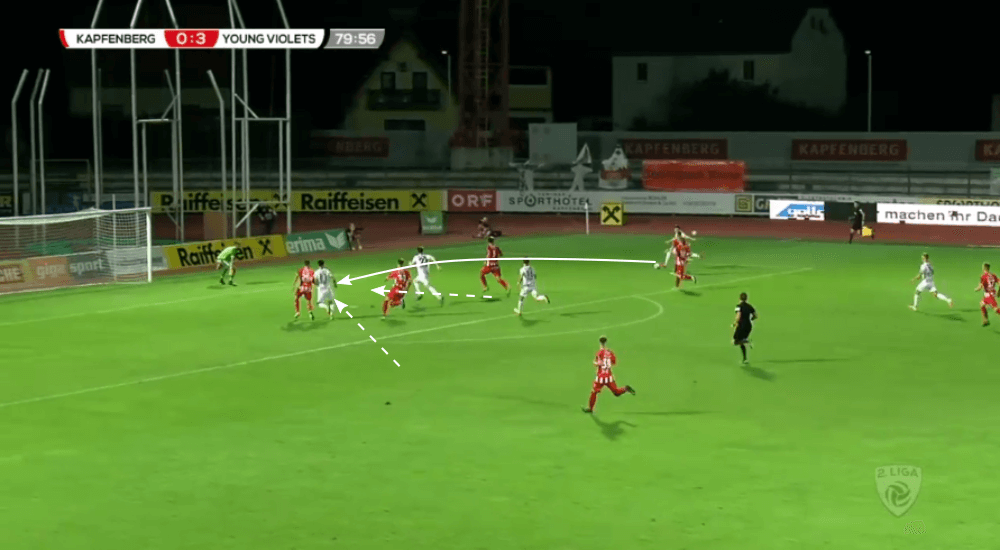
In those situations, the players in the centre should continue their forward run to get on the ball at full speed.
Anyways, when the ball-carrier in the wide area is already close to the goal line and therefore there is also not that much distance between the keeper and the strikers/the defenders, he should look for a low ball towards the space around the penalty spot where at least one player should arrive. The following situation is a perfect example.

To conclude, through passes followed by shots or low crosses are the main principles how they try to create a goalscoring chance and we have to clearly distinguish between two different kinds of low crosses.
Conclusion
Young Violets under Suchard are definitely a team with interesting tactics in possession with a clear plan and different principles they follow. The most interesting aspect is probably that the players should take risks at every time of the build-up what perfectly suits this young group of players.
Within the recent season, several players got promoted to be a regular part of the first team of Austria Vienna and also some players who are still with Young Violets made a few appearances for the senior squad.
Also, Peter Stöger is the new head coach of Austria Vienna and he may try to implement even more players from the second squad what means that new and younger players will get the chance to show themselves in the team of Suchard.





Comments